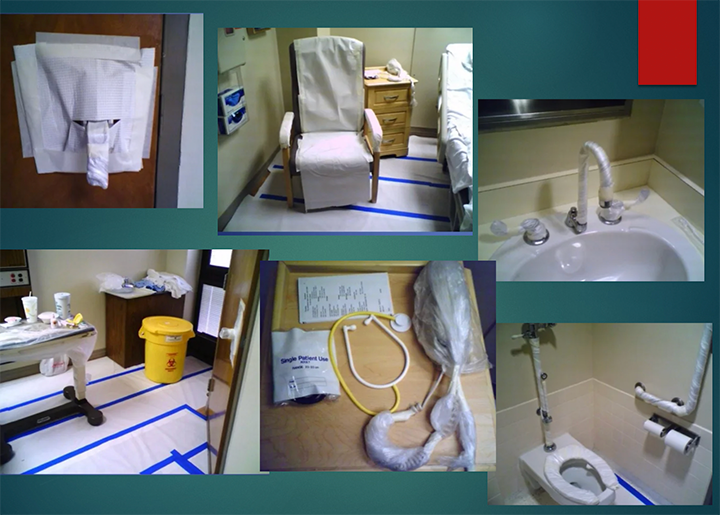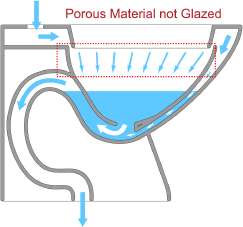- Doses of greater than 33 mCi may under certain circumstances require hospitalization when there is a danger to the public
- Patients are usually released following a dose greater of greater than 33 mCi, but specific criteria, defined by the NRC must be utilized
- Releasing the patient following the administration after a dose greater than 33 mCi, and determining if a patient is allowed to be released to the general public
- Ideally - The patient should stay home and be by him/herself
- If other family members are around then the exposure level should be limited to total dose of 500 mrem
- If there is a spouse or significant he/she should not share the bedroom for at least 5 to 7 days (however, this is dependent on the amount of radiation being emitted)
- If there are small children present they should not be exposure to family member given the therapy
- Breastfeeding must be discontinued
- The patient can go to work if no one in the workplace is going to receive less than 500 mrem (work alone)
- Liquid iodine (131I) is volatile and special caution should be used when it is administered (beyond the concern of it being a radioactive substance)
- Bioassays should be done on any employee involved with treating patients with "radiopharmaceutical therapy" for assessment of 131I burden to the thyroid. This should be done within 24 to 72 post treatment. See NUREG-1556, Volume 9 Rev 2: http://pbadupws.nrc.gov/docs/ML0734/ML073400289.pdf The frequency in which a bioassay is done should be based on the following:
- "The potential exposure of the individual;
- "The retention and excretion characteristics of the radionuclide
- "The sensitivity of the measurement technique; and
- "The acceptable uncertainty in the estimate of intake and committed dose equivalent."
- From the above chart, several points should be noted when completing a bioassay
- Establish a baseline prior to patient dosing
- Count the thyroid with an uptake probe making sure that you know its efficiency with a 364 keV gamma
- If the thyroid dpm reaches 2.22 x 106 the an evaluation should be done to determine WHY?
- If the trigger level reaches 1.11 x 107 dpm then a thorough investigation is required.
- Additional key points
- Because of the volatility of iodine the pill form is suggested over liquid
- The cost of the pill is significantly higher than the liquid
| I-131 Intake Level | Activity Action Level for I-131 |
| Evaluation Level | 1 µCi (2.22 x 106 dpm) 0.02 ALI |
| Investigation Level | 5 µCi (1.11 x 107 dpm) 0.1 ALI |
- Setup patient that must be hospitalized for his/her ablation dose
- The patient requires a private room/bath and should be setup as if the patient is on total isolation (remember your patient care?)
- The room must be labeled, outside the door, "Caution Radiation Material"
- Nursing staff must be educated on the three rule of radiation safety
- Since the patient's secretions are radioactive absorbent material must be attached to anything the patient touches
- Phone
- Bed railing
- Floor (to and from bathroom)
- Toilet seat
- Bathroom
- Everything!
- Use disposal materials plates and utensils whenever possible to be discarded in separate trash containers
- A separate container must be used to discard linen and towels
- Everything that leaves the room (trash, linen, plates, utensils, patients clothing, etc.) must be monitored. If contamination is discovered, then it must be held in a special storage facility until the contaminated materials reaches background
- Once the patient is dosed he/she must be surveyed
- At bedside
- At 3 feet
- At the door
- The room next door
- Outside the room the exposure level should be below 2 mrem
- By law you are to not exceed specific radiation levels/exposures to the public
- 100 mrem per year
- 2 mrem in 1 hour
- Questions regarding this calculation
- How long will the nurse be in the room of the patient undergoing treatment?
- Will the nurse be at the patient's bedside or at a three-foot distance?
- Will be patient in the next room exceed the above limits?
- The patient can be discharged when the dose of iodine is below 33 mCi or less than 7 mrem at 1meter
- Remember all the patient's excreta is hot!

Room and bathroom prep
- How long does a 200 mCi dose take before it reaches 33 mCi in the patient?
- Usually about 72 hours
- Forcing fluids may cut this time in half
- 10CFR35.75 - Numbers you need to remember
- Technically, any dose above 33 mCi needs to be treated as an inpatient
- The patient can be discharged following their therapeutic dose given the following regulations
<
- Patient is given a "written directive" that addresses radiation safety
- TEDE to any person cannot exceed 0.5 rem
- Radiation safety instructions must be given to any person that is going to receive 0.1 rem or greater
- Breast-feeding must be discontinued
- Outline the consequences if the written directive is not followed
- If any person working with the patient is going to receive 0.5 rem or more than the patient must be hospitalized
- Patients that are hospitalized can be released if
- There is <33 mCi on board
- If the radiation exposure at 1 meter is <7 mr/hour
- After patient discharge
- The room must be surveyed and all contamination must removed
- Areas of concern are:
- Toilet - check under the lip
- Shower
- Sink
- Anything that was not covered with absorbent paper
- If the GM meter finds any contamination it should be cleaned with a solution of bleach and water (this is less expensive and more effective than the commercial cleaner)
- If the GM meter finds the contamination it must be removed!
- Wipe testing must be completed to confirms that contamination has been removed
- Only when background levels are identified with wipe testing is the room considered decontaminated
- All disposal trash, linen, towels, and patients clothing must be monitored
- If any contamination is identified it must be stored till background
- This requires at least 80 days and may be as much as 120 days
- Following decay, any/all disposed material must be recorded as such
- Any area of contamination must be removed via cleaning and recorded as such
- Once the room has been cleaned of contamination it can be released back to the hospital
- Possible side effects from thyroid treatment
- Sialoadenitis - Pain, swelling, and tenderness of the salivary glands occur during the therapy procedure
- It occurs 10 - 33% of the a time and increases in probability based on the an increase dose to the patient
- Administration of hard sour candy can reduce this effect
- Why do you think this happens?
- Xerostomia occurs after the therapy is over
- In about 1/3 of the treated patient for about a year
- Xerostomia diminishes over time, however, 14% of patients still have this after 3 years
- About 4% will always have this disorder
- GI issue(s) is less than 1%
- Thyroid storm may occur between 2 to 10 after therapy
- Temporary loss of taste and smell can occur with up to 50% of the patients receiving therapy
- Radiation sickness may only be seen if the dose is greater than 200 mCi
- Breast, bladder, salivary cancers, and Leukemia have a slight increase in occurrence
- Hypothyroidism is always an end result
- Sialoadenitis - Pain, swelling, and tenderness of the salivary glands occur during the therapy procedure

Return to the Beginning of the Document
Return to the Table of Content
Next Lecture - Other Therapies
6/22